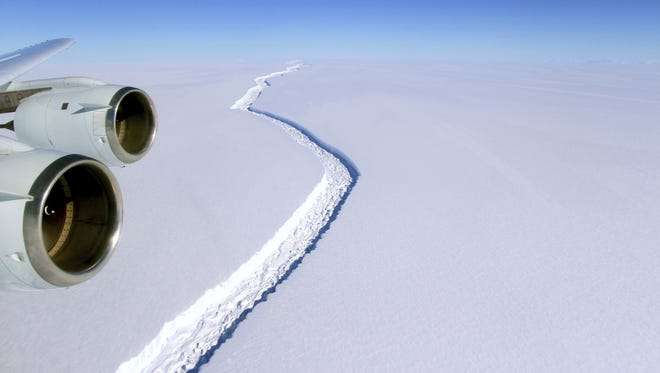Antarctic iceberg break 'imminent,' likely in 'hours, days or weeks'
 Doyle Rice
Doyle RiceOne of the world's biggest icebergs ever recorded is "hours, days, or weeks" away from breaking off an Antarctic ice shelf, scientists announced Wednesday.
"In another sign that the iceberg calving is imminent, the soon-to-be-iceberg part of Larsen C Ice Shelf has tripled in speed to more than 10 meters per day between June 24th and June 27th," said Adrian Luckman of Project MIDAS, a British Antarctic research project that's keeping watch on the ever-growing crack.
"The iceberg remains attached to the ice shelf, but its outer end is moving at the highest speed ever recorded on this ice shelf. We still can’t tell when calving will occur — it could be hours, days or weeks," he added.
Once the iceberg breaks off, it "will fundamentally change the landscape of the Antarctic Peninsula," he said.
More:Antarctica's expanding ice-free areas threaten animals and plants, study says
Ice shelves are permanent floating sheets of ice that connect to a land mass, according to the National Snow and Ice Data Center. Since the ice is already floating, the newly created iceberg won't contribute to rising sea levels.
Still, studying ice shelves and icebergs is important because they "hold back the glaciers that 'feed' them," Luckman said. "When they disappear, ice can flow faster from the land to the ocean and contribute more quickly to sea-level rise."
After the berg breaks off, Larsen C will be less stable than it was prior to the rift, and the ice shelf could eventually follow the dramatic example of its neighbor Larsen B, which disintegrated in 2002 following a similar rift-induced calving event.
After that break, the number of glaciers behind it accelerated and are still flowing faster than before.
Project MIDAS said there is no evidence to link the growth of this rift, and the eventual calving, to climate change.
However, it is widely accepted that warming ocean and atmospheric temperatures have been a factor in earlier disintegrations of ice shelves elsewhere on the Antarctic Peninsula, most notably Larsen A in 1995 and Larsen B in 2002.
Global warming has pushed temperatures up to 5 degrees higher in the region since the 1950s and could increase up to 7 degrees more by the end of the century, putting more stress on ice, according to Climate Central.
